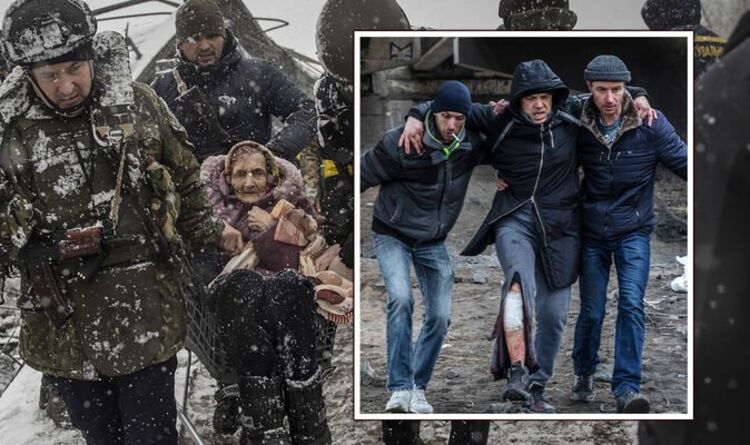Putin ‘never intended’ to let refugees escape in bloodthirsty return to ‘cynical’ strategy
Putin is a 'phenomenal liar' says former PM David Cameron
We use your sign-up to provide content in ways you’ve consented to and to improve our understanding of you. This may include adverts from us and 3rd parties based on our understanding. You can unsubscribe at any time. More info
Since the Russian invasion of Ukraine on February 24, the United Nations estimates more than two million people have fled the country – the biggest exodus of refugees in Europe since the end of World War 2. But hundreds of thousands of civilians remain trapped in besieged regions of Ukraine under heavy shelling from Russian forces. Ukraine’s Foreign Ministry has warned Russian attacks was preventing the evacuation of civilians from Kyiv, Mariupol, Sumy, Kharkiv, Volnovakha and Mykolaiv.
During negotiations, Russia and Ukraine agreed on the need for humanitarian corridors to evacuate civilians from war-torn areas.
Efforts over the past week to evacuate civilians were repeatedly abandoned after Russian forces continued to bombard densely populated residential areas, with civilians trying to take the routes to safety themselves coming under fire.
Residential buildings were repeatedly shelled and some “safe roads” mined, Ukrainian authorities warned.
Defence analyst Professor Michael Clarke, former director-general of the Royal United Services Institute, told Express.co.uk: “The Russians manipulate these humanitarian corridors. They use them very cynically. And if they work, then good because it gets some people out. But they won’t make a big strategic difference.


“And the fact that the first two corridors on Saturday and Sunday, out of Mariupol, broke down – I was not remotely surprised because I don’t really think they ever intended for them to work.
“The Ministry of Defence got it right; they said that they think [Russia was] using the prospect of corridors for a ceasefire to move their own forces around.
“And they want the propaganda victory of saying look, we’re doing all we can to minimise civilian casualties.
“But actually they don’t want to minimise them because they use civilian casualties and threats to civilians as part of their war strategy.
“That’s what they do, that is the way they think about siege warfare around cities, judging by what they did in Chechnya and Syria.
“So that they are back in the old routine. In more or less every respect at the moment.”
Amongst the worst affected areas is the southeastern port city of Mariupol.
Residents in Mariupol have been without power, sanitation and basic necessities for more than a week.


Bodies have been left lying in the street, and there have been fires burning across the city which has faced relentless shelling for 10 days.
Ukrainian President Volodymyr Zelensky said a six-year-old girl, Tanya, had died of dehydration after the Russian military cut off the water supply.
Commenting on the tragic death, the city’s mayor, Vadym Boychenko, said: “Her mother was killed.
“We can’t imagine how much suffering she had to bear. In the last minutes of her life she was alone, weak, frightened, thirsty.”
All attempts to move civilians out of Mariupol using humanitarian corridors have been thwarted by Russian shelling.
One of the few successful humanitarian corridors has been in northeastern city of Sumy.
Dozens of buses carrying Ukrainians and foreign nationals left Sumy in the direction of the southwest.
India said it had evacuated more than 700 of its students from the city. It has a large population of international students.
Professor Clarke, associate director of the University of Exeter’s Strategy and Security Institute, added: “As far as I know, only the ones around Sumy seem to be working.
“Interestingly, somebody pointed out to me that there’s a lot of Indian students in Sumy and Russia would not want to upset India at the moment.
“And India is very worried about all their students in Sumy – and there are a lot of other international students in Sumy as it happens, and I wonder how far the idea of making the Sumy corridors work is influenced by the number of foreign students who are there.”
The governor of the Kyiv region said 150 people had also been successfully evacuated via an unofficial route from Irpin, near the capital.
Ukraine’s Red Cross also reported successfully evacuating a group of pensioners who had been trapped in a private home in Irpin, which remains the scene of fierce fighting.
Further ceasefire talks between the two sides are expected in the coming days but, after successive failures, negotiators warned not to expect any rapid breakthroughs.
Source: Read Full Article


